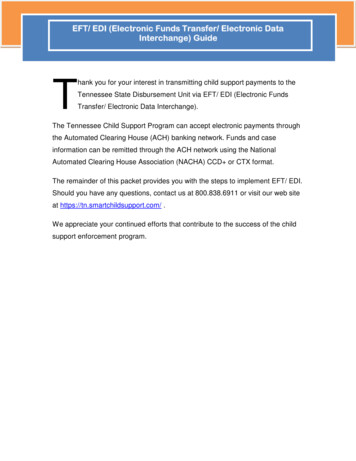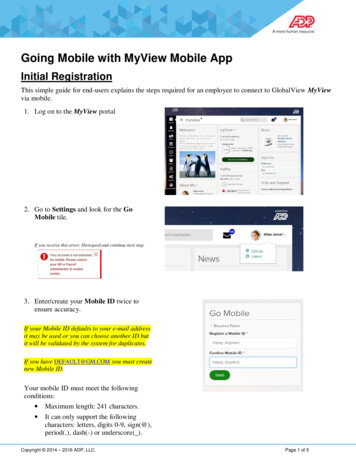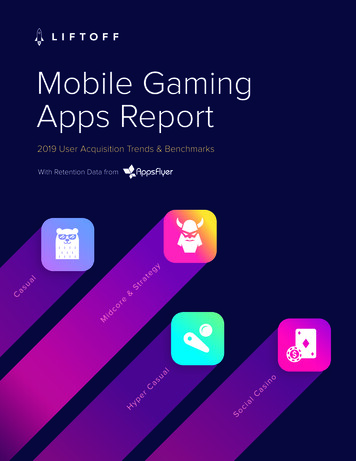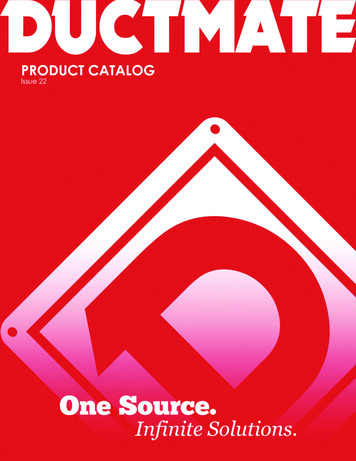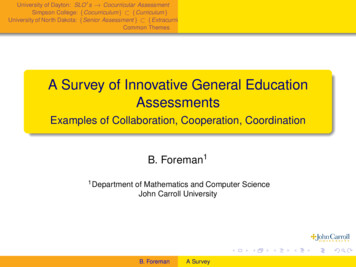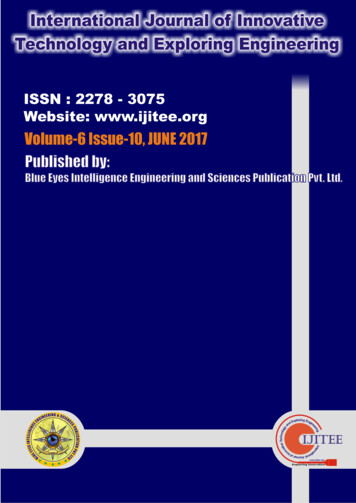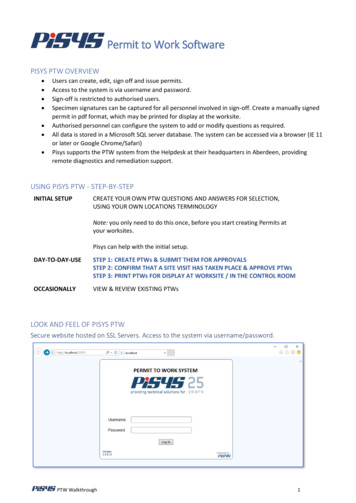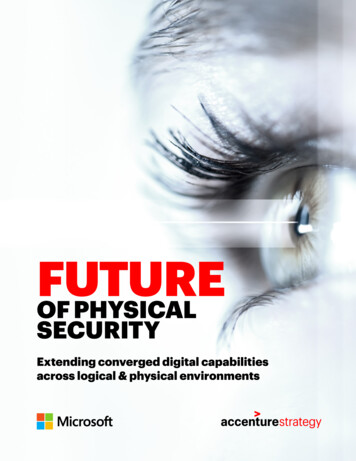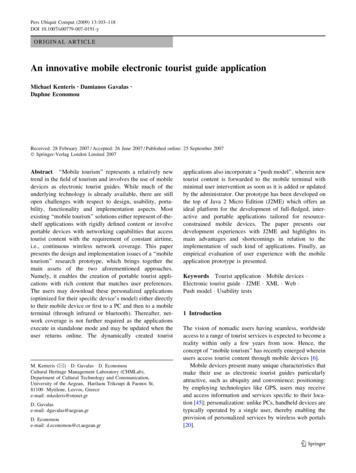
Transcription
Pers Ubiquit Comput (2009) 13:103–118DOI 10.1007/s00779-007-0191-yORIGINAL ARTICLEAn innovative mobile electronic tourist guide applicationMichael Kenteris Æ Damianos Gavalas ÆDaphne EconomouReceived: 28 February 2007 / Accepted: 26 June 2007 / Published online: 25 September 2007 Springer-Verlag London Limited 2007Abstract ‘‘Mobile tourism’’ represents a relatively newtrend in the field of tourism and involves the use of mobiledevices as electronic tourist guides. While much of theunderlying technology is already available, there are stillopen challenges with respect to design, usability, portability, functionality and implementation aspects. Mostexisting ‘‘mobile tourism’’ solutions either represent of-theshelf applications with rigidly defined content or involveportable devices with networking capabilities that accesstourist content with the requirement of constant airtime,i.e., continuous wireless network coverage. This paperpresents the design and implementation issues of a ‘‘mobiletourism’’ research prototype, which brings together themain assets of the two aforementioned approaches.Namely, it enables the creation of portable tourist applications with rich content that matches user preferences.The users may download these personalized applications(optimized for their specific device’s model) either directlyto their mobile device or first to a PC and then to a mobileterminal (through infrared or bluetooth). Thereafter, network coverage is not further required as the applicationsexecute in standalone mode and may be updated when theuser returns online. The dynamically created touristM. Kenteris (&) D. Gavalas D. EconomouCultural Heritage Management Laboratory (CHMLab),Department of Cultural Technology and Communication,University of the Aegean, Harilaou Trikoupi & Faonos St,81100 Mytilene, Lesvos, Greecee-mail: mkederis@otenet.grD. Gavalase-mail: dgavalas@aegean.grD. Economoue-mail: d.economou@ct.aegean.grapplications also incorporate a ‘‘push model’’, wherein newtourist content is forwarded to the mobile terminal withminimal user intervention as soon as it is added or updatedby the administrator. Our prototype has been developed onthe top of Java 2 Micro Edition (J2ME) which offers anideal platform for the development of full-fledged, interactive and portable applications tailored for resourceconstrained mobile devices. The paper presents ourdevelopment experiences with J2ME and highlights itsmain advantages and shortcomings in relation to theimplementation of such kind of applications. Finally, anempirical evaluation of user experience with the mobileapplication prototype is presented.Keywords Tourist application Mobile devices Electronic tourist guide J2ME XML Web Push model Usability tests1 IntroductionThe vision of nomadic users having seamless, worldwideaccess to a range of tourist services is expected to become areality within only a few years from now. Hence, theconcept of ‘‘mobile tourism’’ has recently emerged whereinusers access tourist content through mobile devices [6].Mobile devices present many unique characteristics thatmake their use as electronic tourist guides particularlyattractive, such as ubiquity and convenience; positioning:by employing technologies like GPS, users may receiveand access information and services specific to their location [45]; personalization: unlike PCs, handheld devices aretypically operated by a single user, thereby enabling theprovision of personalized services by wireless web portals[20].123
104Pers Ubiquit Comput (2009) 13:103–118However, several restrictions of mobile computing needto be carefully evaluated by tourist service providers:restricted energy capacity, limited computing power,amount of memory and storage space; small display size,limited color and font number support, small and hard touse keyboard; limited bandwidth and high cost of wirelessconnections. Admittedly, although the capabilities of themobile devices increase, the ‘resource gap’ between mobileand stationary devices will always be there.Most existing commercial applications and researchapproaches in the field of mobile tourism basically fallwithin three main categories that involve: tourist or museum guides with pre-installed applications, namely rigidly defined content (in text, visual andauditory format) that cannot be customized accordingto user preferences (e.g., [7, 37]);mobile devices used to access mobile web portals andbrowse tourist information of interest (e.g., [13]);mobile electronic guides devices that use either wireless [2, 10, 39] or mobile network connections [1, 35] toaccess context-aware services.The second approach implies the use of a mobile orwireless network to access Internet resources; wireless webaccess is typically enabled by WAP1 [46] or i-mode2 [38]compatible devices.3 The main disadvantage of i-mode/WAP-based services is their requirement for constantconnection (airtime) of the mobile device with a mobilenetwork to offer access to web content. Thus, users arecharged for the wireless connections (either pay-perminute or pay-per-packet billing policy applies). Similarly,the third approach assumes some type of network connection and tracking systems (e.g., GPS or infrared beacons) toprovide location-based services. Hence, whenever a user isout of coverage of the mobile network (i.e., ‘‘has nosignal’’) he/she cannot access any service [16].This article presents the analysis and design of a citytourist guide system and also its implementation in aprototype system, the myMytileneCity guide. Our prototype includes a database-enabled tourist web site wherein,on a first stage, tourists planning to visit the city of Mytilene (Lesvos Island, Greece) choose the content thatinterests them (lodging, sightseeing, entertainment, etc.);based on that chosen content, the system automaticallygenerates a custom application which can operate on theirmobile phone or PDA. On a second stage, the users maydownload their application either directly to their mobiledevice or first to a PC and then to a mobile terminal(through infrared or bluetooth). In contrast to i-mode/WAP-enabled applications that presuppose continuousconnection to the service provider’s network, the myMytileneCity guide does not pose such requirement. Thatis, following its installation, the application is fully functional with no extra charge, even in places where theconnection to the mobile network is not feasible. Moreover, in contrast to existing applications, themyMytileneCity guide incorporates a ‘‘push model’’.Namely, it enables mobile users to be notified and updatetheir personalized application as soon as new content orservices, which the user has registered to, is added orupdated by the web site’s administrator. Our prototypeimplementation is based on Java 2 Micro Edition (J2ME)which represents an ideal platform for developing powerfuland portable applications operating in asynchronous mode.The remainder of the paper is organized as follows:Sect. 2 reviews related works and Sect. 3 discusses issuesrelated to the design of mobile devices-enabled applications for tourism. Section 4 provides backgroundinformation on the J2ME platform and Sect. 5 presents theimplementation details of our ‘‘mobile tourist guide’’research prototype. Section 6 summarizes our experiencesgained from the prototype development. Section 7 discusses the empirical evaluation of user experience with themobile application prototype and Sect. 8 concludes thepaper and draws directions to further work. Finally, theAppendix includes UML sequence diagrams that explainour proposed application’s design and functionality.1The Wireless Application Protocol (WAP) is a wireless webstandard (released in 1997), backed by the entire telecommunicationindustry (through the WAP Forum). Essentially, WAP specifies aprotocol stack used to submit and deliver data within the boundariesof a mobile/wireless network and a gateway that translates requestsfrom the WAP protocol stack to the WWW stack and vice-versa, sothey can be submitted to web servers.2i-mode is a more recent, alternative to WAP, approach for thewireless Internet, which addresses the main weaknesses arisen withthe practical implementation of WAP. In principle, i-mode is a serviceof wireless Internet (unlike WAP which is a protocol stack), with alarge subscriber base in Japan. It has been released by the JapaneseNTT DoCoMo in 1999.3Recently, a number of WAP and i-mode official and unofficialservices have emerged providing tourist, context-aware [21] andlocation-based services [45], for instance, the i-mode’s i-area [23]service.1232 Related workTourism is a worldwide industry which involves thepropagation of large amounts of information. As in mostindustries, Information Technology has penetrated the fieldof tourism for the manipulation of such information. Theconvergence of IT and communications technologies andthe rapid evolution of the Internet has been one of the mostinfluential factors in tourism that change travelers’behavior.At the same time, the rapid growth of mobile devices(mobile phones, palmtops, PDAs, etc.) user base raises a
Pers Ubiquit Comput (2009) 13:103–118demand for using such devices for accessing Internetresources. The use of mobile devices as means for supporting tourist and cultural activities is not an entirely newidea. In fact, mobile audio guides are being used inmuseum environments for years [15], while the use ofpersonal digital assistants (PDAs) to enhance the museumvisit experience has also been recently proposed [37].Wireless access through mobile devices adds to theInternet connection the element of ‘‘portability’’, i.e.,connection with no time or geographical limitations, bydevices with high penetration to the public [16]; tourists areamongst this technology-oriented public. Hence, a growingbody of commercial and research initiatives that incorporate electronic tourist guide functionality into mobiledevices have been reported [34]. However these technologies in general have had a limited success; this is due tothe lack of an in-depth study of the special characteristicsof tourism, which can draw implications for the design ofmobile tourist applications [6]. In the remainder of thissection, several commercial and research projects withrespect to mobile tourist guides are being reviewed. Client–server interactions and location-based services are the keyfeatures shared among all the reviewed projects.The Guide project was about the city of Lancaster, UK[10]. It used a series of wireless access points to locate auser and derive information for a point of interest via abrowser-based interface. The TellMaris is a NokiaResearch center prototype [35]. It was one of the firstmobile systems to use 3D graphics in combination with 2DMaps and has been developed for the city of Tonsberg inNorway. The LOcal Location assistant (LoL@) project wasa mobile tourist guide designed for the city of Vienna usingthe UMTS Mobile Telecommunication system [1]. Thissystem was one of the first projects based on next generation mobile phone technology. The REAL project was ahybrid pedestrian navigation system which helps the userto find information by generating a graphical routedescription [2]. Its location tracking system is based onGPS/compass signals outdoors and infrared beaconsindoors.All reviewed projects assume some type of networkconnection as a basis of location-based services provision:either a wireless [2, 10] or a mobile network infrastructure[1, 35]. Also, most of these projects (with the exception ofLoL@) have not been designed for mobile phone usage;rather they were programmed for specific PDA platforms.Furthermore, all the abovementioned projects are based onthe assumption that the user initiates the search, browsingand download of tourist information (‘‘pull’’ model). Thatis, under no circumstances the delivery of information withno user intervention is enabled (‘‘push’’ model).In conclusion, the usage of mobile phones as offlinemobile tourist guides requires further research. The105myMytileneCity Guide (developed at our laboratory andpresented herein) addresses the shortcomings of existingsystems. Its main design and implementation objectives arethe following: the system should allow the generation of tourist guideapplications over the Internet, which can later beexecuted on non-networked mobile terminalsthe personalized tourist applications should execute onany mobile device (mobile phones, smart phones,PDAs, palmtops, etc.) independently of their hardwareplatform or operating systemthe applications should enable the dynamic delivery oftourist content with minimal user intervention, giventhat the user has expressed interest on the corresponding content type.The following section discusses issues related to the designof PDA and mobile phone applications, with emphasis ontheir role in tourism.3 Requirements for mobile devices-enabledapplications for tourismThe design of successful mobile devices’ applicationsinvolves factors related to the technical characteristics ofthe devices, the use of the applications [14] and the business model [22].These factors charge the application designers with newchallenges, such as: design for mobility; design for a wideaudience with various levels of competency in the use ofnew technologies, that do not necessarily have a history ofexperience with similar applications to draw on in learninga new one; design for limited input (diminutive andimpractical keyboard)/output facilities (small screen size,limited color and font size support); and design for usermultitasking at levels unfamiliar to most desktop users [5,47]. Unlike PDAs, most of the mobile phone applicationsare downloaded over-the-air (OTA), which implies lack ofuser manuals, long installation time and possibly highdownload cost. Mobile phone devices in general have lessprocessing capabilities than PDAs and are not yet fullymultimedia enabled (which are important issues fordevelop
mobile systems to use 3D graphics in combination with 2D Maps and has been developed for the city of Tonsberg in Norway. The LOcal Location assistant (LoL@) project was a mobile tourist guide designed for the city of Vienna using the UMTS Mobile Telecommunication system [1]. This system was one of the first projects based on next gener- ation mobile phone technology. The REAL project was a .

